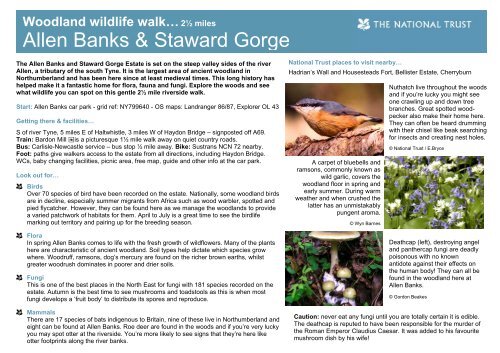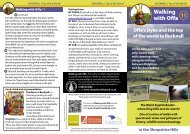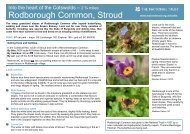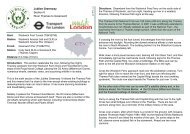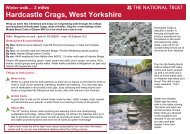You also want an ePaper? Increase the reach of your titles
YUMPU automatically turns print PDFs into web optimized ePapers that Google loves.
Woodland wildlife walk… 2½ miles<strong>Allen</strong> <strong>Banks</strong> & Staward GorgeThe <strong>Allen</strong> <strong>Banks</strong> and Staward Gorge Estate is set on the steep valley sides of the river<strong>Allen</strong>, a tributary of the south Tyne. It is the largest area of ancient woodland inNorthumberland and has been here since at least medieval times. This long history hashelped make it a fantastic home for flora, fauna and fungi. Explore the woods and seewhat wildlife you can spot on this gentle 2½ mile riverside walk.Start: <strong>Allen</strong> <strong>Banks</strong> car park - grid ref: NY799640 - OS maps: Landranger 86/87, Explorer OL 43Getting there & facilities…S of river Tyne, 5 miles E of Haltwhistle, 3 miles W of Haydon Bridge – signposted off A69.Train: Bardon Mill qis a picturesque 1½ mile walk away on quiet country roads.Bus: Carlisle-Newcastle service – bus stop ½ mile away. Bike: Sustrans NCN 72 nearby.Foot: paths give walkers access to the estate from all directions, including Haydon Bridge.WCs, baby changing facilities, picnic area, free map, guide and other info at the car park.Look out for…t BirdsOver 70 species of bird have been recorded on the estate. Nationally, some woodland birdsare in decline, especially summer migrants from Africa such as wood warbler, spotted andpied flycatcher. However, they can be found here as we manage the woodlands to providea varied patchwork of habitats for them. April to July is a great time to see the birdlifemarking out territory and pairing up for the breeding season.t FloraIn spring <strong>Allen</strong> <strong>Banks</strong> comes to life with the fresh growth of wildflowers. Many of the plantshere are characteristic of ancient woodland. Soil types help dictate which species growwhere. Woodruff, ramsons, dog’s mercury are found on the richer brown earths, whilstgreater woodrush dominates in poorer and drier soils.t FungiThis is one of the best places in the North East for fungi with 181 species recorded on theestate. Autumn is the best time to see mushrooms and toadstools as this is when mostfungi develops a ‘fruit body’ to distribute its spores and reproduce.t MammalsThere are 17 species of bats indigenous to Britain, nine of these live in Northumberland andeight can be found at <strong>Allen</strong> <strong>Banks</strong>. Roe deer are found in the woods and if you’re very luckyyou may spot otter at the riverside. You’re more likely to see signs that they’re here likeotter footprints along the river banks.National Trust places to visit nearby…Hadrian’s Wall and Housesteads Fort, Bellister Estate, CherryburnA carpet of bluebells andramsons, commonly known aswild garlic, covers thewoodland floor in spring andearly summer. During warmweather and when crushed thelatter has an unmistakablypungent aroma.© Wyn BarnesNuthatch live throughout the woodsand if you’re lucky you might seeone crawling up and down treebranches. Great spotted woodpeckeralso make their home here.They can often be heard drummingwith their chisel like beak searchingfor insects and creating nest holes.© National Trust / E.BryceDeathcap (left), destroying angeland panthercap fungi are deadlypoisonous with no knownantidote against their effects onthe human body! They can all befound in the woodland here at<strong>Allen</strong> <strong>Banks</strong>.© Gordon BeakesCaution: never eat any fungi until you are totally certain it is edible.The deathcap is reputed to have been responsible for the murder ofthe Roman Emperor Claudius Caesar. It was added to his favouritemushroom dish by his wife!
Walk terrain and accessibility2½ mile circular walk following brown trail markers along natural and surfacedfootpaths. The route is relatively flat but with some short sharp climbs. There aresome narrow sections with steep drops to the river <strong>Allen</strong>.Route directionsStarting at the car park, follow the main footpath into the woodland. Brown way-markarrows lead you on the route.1. Take the lower, left-hand fork in the path. The river <strong>Allen</strong> comes into view.2. The path drops close to the waterside and the woodland opens out. The river isrocky and fast flowing here, a prime spot for birds like dipper and grey wagtail.Heron and goosander can also be seen stalking prey throughout the year.3. At a bend of the river walk under Raven Crag the river becomes deeper andslows to creating a flat pool where, on summer evenings, Daubenton’s bats skimjust above the water surface feeding on insects.4. Decaying fallen trees on the banks above you here are part of the life cycle of thewoodland. Insects and fungi feed on and break down the rotting timber, returningvital nutrients to the soil. Woodpeckers and other birds then feed on the insectsand create nests in the standing deadwood.5. After crossing the Kingswood burn, turn left and cross the Plankey Mill Bridgeover the river <strong>Allen</strong>. Walk right towards the farm buildings and join the public roadwhich travels left for about 100m. Take the track to the left of this road whichheads down to a kissing gate near the river and old ruins.6. Walk through meadows along the river bank. Alder trees line the river which havelichen covered stems and branches. Lichens require clean air so are goodindicators of pollution-free areas. During the summer keep a look out forwildflowers such as field pansies, orchid and yellow rattle near the river and inthe hay fields here. They make it a great habitat for a wide range of butterflies.7. Enter the woodland opposite Raven Crag and soon take to a higher level path.8. You return to the riverside and cross the water again at a suspension bridge.Turn right when you reach the far bank and walk back to the car park.© Reproduced by permissionof Ordnance Survey.All rights reserved.OS licence no. AL 100018591As a charity, independent of government, the National Trust relies on the generosity of its supporters to continue caring for our countryside and wildlife,so that everyone can enjoy the beauty of the outdoors for generations to come.Find out more at www.nationaltrust.org.uk


